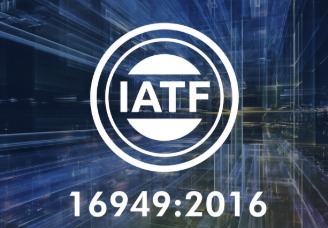IATF 16949:2016 – Automotive Quality Management System (QMS): Driving Global Excellence in the Automotive Industry
In the highly competitive automotive industry, maintaining consistent quality, safety, and reliability across the supply chain is essential. The success of an automotive manufacturer depends not only on innovation and design but also on robust processes that ensure defect-free production and customer satisfaction. To achieve these goals, organizations rely on the globally recognized standard IATF 16949:2016 — the cornerstone of automotive quality management systems.
What is IATF 16949:2016?
IATF 16949:2016 is an international standard that defines the requirements for a Quality Management System (QMS) specifically for the automotive sector. It was developed by the International Automotive Task Force (IATF) in collaboration with the International Organization for Standardization (ISO) and is fully aligned with ISO 9001:2015.
While ISO 9001 provides a general framework for quality management, IATF 16949 adds specific automotive industry requirements focused on defect prevention, continuous improvement, and reducing variations and waste in the supply chain.
This standard applies to all organizations involved in the design, development, production, installation, and servicing of automotive components. It is recognized and accepted by major automotive manufacturers (OEMs) worldwide as the industry benchmark for quality excellence.
Objectives of IATF 16949:2016
The key objectives of IATF 16949 are:
-
To promote defect prevention rather than defect detection
-
To reduce variations and waste throughout the supply chain
-
To ensure consistent product quality and safety
-
To enhance customer satisfaction through effective process control
-
To support continual improvement in all aspects of the organization
-
To align automotive suppliers with global industry expectations
By implementing IATF 16949, organizations can build a culture of quality, transparency, and accountability, ensuring long-term business success.
Why is IATF 16949 Important for the Automotive Industry?
The automotive sector operates with complex supply chains and strict regulatory requirements. Even minor defects can lead to costly recalls, reputational damage, and safety risks. Therefore, automotive manufacturers and suppliers need a structured quality management system that ensures consistency and reliability at every stage of production.
IATF 16949 provides a systematic framework for managing risks, ensuring process standardization, and meeting customer-specific requirements. It is not just a certification—it’s a commitment to excellence, safety, and continuous improvement.
Key Principles of IATF 16949:2016
The standard is based on the same quality management principles as ISO 9001 but includes additional requirements unique to the automotive industry. The key principles are:
-
Customer Focus – Meeting and exceeding customer expectations.
-
Leadership Commitment – Establishing strong management involvement and accountability.
-
Process Approach – Managing activities and resources as processes for greater control.
-
Risk-Based Thinking – Identifying and mitigating risks proactively.
-
Evidence-Based Decision Making – Using data to drive improvement.
-
Continuous Improvement – Striving for excellence at every stage of production.
-
Supplier Quality Management – Ensuring quality and consistency across the entire supply chain.
Structure of IATF 16949:2016
IATF 16949 follows the Annex SL structure, making it easily integrable with other management system standards like ISO 9001, ISO 14001 (Environmental Management), and ISO 45001 (Occupational Health & Safety).
The key clauses of IATF 16949 include:
-
Scope
-
Normative References
-
Terms and Definitions
-
Context of the Organization
-
Leadership
-
Planning
-
Support
-
Operation
-
Performance Evaluation
-
Improvement
Each clause helps organizations establish a systematic framework for managing processes, resources, risks, and continual improvement.
Who Can Apply for IATF 16949 Certification?
IATF 16949 certification is applicable to:
-
Automotive component manufacturers
-
Tier 1, 2, and 3 suppliers
-
Companies involved in production and service parts
-
Heat treatment, coating, and welding service providers
-
Organizations supplying parts to OEMs (Original Equipment Manufacturers)
Any organization that contributes to the automotive production or service part supply chain can benefit from this certification.
Benefits of IATF 16949:2016 Certification
Implementing IATF 16949 offers numerous operational, financial, and reputational advantages:
1. Improved Product Quality
By establishing a robust QMS, organizations ensure that every part meets strict quality specifications, reducing defects and rework.
2. Enhanced Customer Satisfaction
The focus on customer-specific requirements builds trust and strengthens long-term relationships with OEMs and global clients.
3. Global Market Recognition
IATF 16949 is recognized by all major automotive manufacturers worldwide, helping suppliers access global markets and increase competitiveness.
4. Operational Efficiency
The standard drives process optimization, reducing waste, inefficiencies, and downtime across the production line.
5. Risk Management
Through proactive risk identification and mitigation, organizations can prevent product failures, recalls, and financial losses.
6. Supply Chain Integration
It ensures that suppliers maintain the same high-quality standards, resulting in a stronger, more reliable supply chain.
7. Continuous Improvement Culture
Regular audits, performance evaluations, and data-driven decisions foster a culture of continual improvement and innovation.
Implementation Steps for IATF 16949:2016
Achieving certification requires a structured approach. Here’s a simplified roadmap:
-
Understand the Standard:
Study the requirements of IATF 16949:2016 and identify their applicability to your processes.
-
Conduct a Gap Analysis:
Evaluate your existing QMS against the standard’s requirements and identify areas for improvement.
-
Develop Documentation:
Prepare necessary policies, procedures, manuals, and process documentation aligned with the standard.
-
Train Employees:
Build competence and awareness among staff to ensure effective implementation.
-
Implement the System:
Apply the documented QMS processes across all relevant departments and activities.
-
Internal Audit:
Conduct internal audits to verify compliance and effectiveness.
-
Management Review:
Review system performance and make necessary improvements.
-
Certification Audit:
Engage an accredited certification body to conduct the final audit and issue the IATF 16949 certificate.
IATF 16949:2016 and ISO 9001:2015 – The Connection
While IATF 16949 is based on ISO 9001, it cannot stand alone. To achieve IATF certification, an organization must first comply with ISO 9001:2015 requirements.
ISO 9001 provides the general framework for quality management, whereas IATF 16949 adds automotive-specific requirements such as:
Together, these two standards provide a complete framework for quality excellence in the automotive industry.
Conclusion
In today’s rapidly evolving automotive landscape, IATF 16949:2016 has become the gold standard for quality management. It enables organizations to build a culture of excellence, efficiency, and reliability that extends across the entire supply chain.
By implementing IATF 16949, automotive companies demonstrate their commitment to continuous improvement, customer satisfaction, and global quality standards. It is not just a certification—it’s a strategic investment in trust, credibility, and long-term business growth.
If your organization operates in the automotive industry, obtaining IATF 16949 certification can open doors to new opportunities, strengthen supplier relationships, and drive sustainable success.






